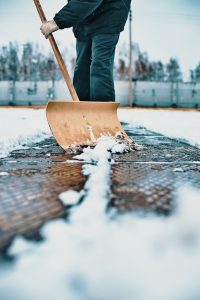Winter Mayhem – 8 Snow Shoveling Safety Tips for Healthier, Safer Winter Season
 If you live in Wisconsin or another cold-winter state, you will inevitably see snow between November and April. That first snowfall looks so beautiful on pine trees, but as that fluffy stuff accumulates, you will have to get outside and shovel. Snow may be ideal for snowboarders, skiers, and snowmobilers. But when it comes to keeping driveways and sidewalks clear of the heavy white stuff, we need to be prepared with snow shoveling safety tips to avoid injuries.
If you live in Wisconsin or another cold-winter state, you will inevitably see snow between November and April. That first snowfall looks so beautiful on pine trees, but as that fluffy stuff accumulates, you will have to get outside and shovel. Snow may be ideal for snowboarders, skiers, and snowmobilers. But when it comes to keeping driveways and sidewalks clear of the heavy white stuff, we need to be prepared with snow shoveling safety tips to avoid injuries.
The American Heart Association says most individuals who head out to shovel snow will be fine. But for others, the combination of colder temperatures and physical exertion can place an increased workload on both your lower back, shoulders, and heart, boosting the risk of having muscle strains or even a heart attack. Why the added risk? In cold weather, blood vessels become constricted, and your muscles become tighter. Tighter muscles make it harder for blood to pass through them and work properly. Plus, repetitive bending, pushing, lifting, twisting, and throwing snow, can wreak havoc on various muscles to the point of exhaustion.
Thousands of people suffer from snow-shoveling injuries annually, and many are avoidable. Orthopaedic Hospital of Wisconsin physical therapist David Tranchita, MA, PT, CMTPT, CSCS, of Greenfield and New Berlin Physical Therapy describes a few simple snow shoveling safety tips to minimize sore muscles and help you avoid hurting your back and even prevent more severe injuries. By stretching, practicing proper form, and taking frequent breaks, you can clear your driveway pain-free and enjoy more time with loved ones.
Who Is Most At Risk Of Injury When Shoveling?
Anyone not using proper form and taking care of their body is more likely to get injured while shoveling. A nearly 20-year study from The Center for Injury Research and Policy shows that about 11,500 people are injured from snow-related incidents each year. Most of these are orthopedic injuries. Approximately half of these are muscle-related, and about one-third are in the lower back. This study also revealed who has the highest risk for injury during snow removal.
People over 55 years old are more likely to get hurt during snow shoveling due to a fall. This age group accounts for over 21 percent of all snow shoveling-related injuries annually. Men incur about two-thirds of annual snow shoveling injuries.
How Can You Prevent Injuries While Shoveling?
The best medicine is preventative medicine. Before you even pick up the shovel, you can do several things to prepare to clear your sidewalk and driveway. Taking care of yourself before you begin a physically demanding task like shoveling can help you avoid injury and lessen your exertion. Below are our top snow shoveling safety tips.
8 Tip Snow Shoveling Safety Tips

1. START LATER IN THE DAY
Statistics show you are more likely to sustain a back injury in the morning. Your spinal discs naturally swell at this time of day, and your muscles are stiff since you are not active during sleep. You will also have a slower reaction time in the morning, which may increase your fall risk. So, enjoy that morning cup of joe, warm up with a hot breakfast and wait a few hours before you begin shoveling.
2. EAT A HEALTHY SNACK OR MEAL
A healthy diet will not prevent injury but can help prepare your body for physical exercise. We recommend eating foods rich in protein and complex carbohydrates before shoveling snow. These foods will fuel your muscles with vital nutrients and give you the energy to sustain yourself. Protein and complex carbs are packed with amino acids and will hydrate your muscles to help you recover quickly. Breakfast foods chock-full of complex carbs and proteins include eggs, oatmeal, low-sugar Greek yogurt, and shredded wheat.
3. HYDRATE YOUR BODY
Your muscles and disks in your back are 70 percent water, so you should start the day by drinking a few glasses of water to prepare the body for exercise. Also, drink during and after physical activities to replenish the fluids lost. If you feel muscle cramping, try a beverage with electrolytes in them, like G2 Gatorade. If you feel lightheaded, nauseous, or disoriented, or your urine smells and is bright yellow, you are probably dehydrated. Drinking 50 percent of your body weight in ounces per day is recommended.
4. DRESS IN LAYERS AND GET A GRIP
Be hypersensitive about hypothermia (having an abnormally low body temperature). To prevent hypothermia, dress in layers of warm clothing and wear a hat, as much of your body heat escapes through the head. Wear mittens instead of gloves, and make sure you have good tread on your winter boots to avoid slipping and falling.
5. START SLOW
For the same reason you want to stretch before moving, you do not want to go too fast or lift too much once you begin. Overworking yourself will cause your muscles to fatigue, which may lead to an injury, or make you too tired to clean your entire driveway. Instead, ease yourself into shoveling so you can loosen up and get into a groove as you work.
6. USE PROPER BODY MECHANICS
Your back has a natural curve, and the best way to keep yourself from straining your spine is to maintain that curve while shoveling. If you keep your back too straight or exaggerate the curve, the weaker muscles will bear more weight.
The biggest and strongest muscles in the body are your thigh muscles (quadriceps) and your bottom muscles (gluteals) which can tolerate more load than your smaller back muscles. When you scoop up snow, bend at the knees, not the back, in a squatting position. A wider stance and keeping one leg in front of the other in a lunge or stride position will also help you gain leverage to push and lift. Plus, ergonomically shaped shovels can help distribute the load and lessen the burden on your back.
7. KEEP YOUR SHOVEL LIGHT
The more weight you try to lift, the more stress you will place on your back. Know your limits, and do not try to do more than you can sustain for long periods. Instead of digging down to the asphalt and up-heaving a lot of snow at once, take it piece by piece and skim off the top layer first.
You may want to avoid lifting completely by pushing snow off to the side and using your shovel like a plow rather than lifting heavy snow. If you must do some lifting, it’s best to alternate between hoisting and pushing snow. If possible, consider a snow blower.
8. TAKE BREAKS
When shoveling, be sure to take rest breaks. You mustn’t overtax your muscles or heart. As with any workout, frequent breaks can prevent muscle fatigue and restore breath and energy. A good rule of thumb is to take a 30-second break for every five minutes of shoveling. When you take a break, use that time to stretch. Since you will be leaning forward while shoveling, you can counteract this motion by stretching backward, away from the muscle you’re putting stress on. If you already know you have heart disease, ask somebody else to shovel or plow, especially if the snow is heavy and wet.
Should you injure yourself while snow shoveling or doing any other activity, make an appointment with one of our orthopedic specialists as soon as possible. Our team can assess your injury and provide you with the best plan to get you pain and injury-free.

